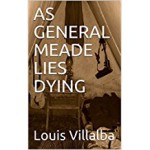
On a solitary beach on the outskirts of town, a young jogger finds a stranded man who greets him in Latin. They walk to downtown where the stranger describes Roman Cadiz—the ancient city of Gades—with all sorts stood twenty centuries ago. Incredulous, the young man listens to him as if his companion of details. Under a dragon tree, he points to the area where his home were out of his mind. What transpired in the following 24 hours will have an everlasting impact on him and his fellow citizens.

A laborer finds a sack full of silver coins on a beach. He hides his cache and attempts to sell a few coins. An obverse inscription proves that their minting took place in Mexico several centuries earlier. He traces his previous owners—a tycoon, a slave trader, and a pirate—and unveils the story of their lives and the fate of the coins. What he learns rocks him to the core.

In November 1872, George Gordon Meade lies in his deathbed. The General evokes memories of his hometown Cadiz, his father’s loss of a large fortune helping this city during the two-and-a -half year siege by the French, the ungratefulness toward his father, his own disappointment at criticisms after his success in Gettysburg. Landscapes of his hometown intermingle with heroic war scenes as he assesses his life before facing his Maker.

On an official visit to a castle, Alvaro wanders into the inner gardens banned to Christians and comes across Fatimah, the vizier’s youngest daughter. It is love at first sight. After he finds a secret passage, the young lovers continue their forbidden romance. When her father arranges her marriage to the emir, they plan their escape. Their scheme is discovered and, fearing the worst, she makes a daring move to save her lover’s life.

A lonely old man nurses a stray dog that was badly wounded while defending him from a viper’s attack. The man adopts the dog and both initiate a long friendship. One day the master takes ill and an ambulance rushes him to a hospital. As the siren rages on, the dog takes off after the fast-moving vehicle. The events that follow make headlines in newspapers.

After winning a chess contest, a young man from Cadiz comes to Chicago invited by a cousin. Lake Michigan and the cityscape of the host town impress him. He hones his skills in Chicago. He is enthralled by life in the huge metropolis and falls in love with her cousin’s girlfriend. An inner battle takes place as he wrestles with his feelings for this woman, his attraction for the Windy City, and his yearning to return to his hometown.

Intent, a youngster sits amidst the audience at the bullfighting ring in Cadiz. Hidden under his shirt is a red cape. His mind drifts into his efforts and frustrations to become a bullfighter—rehearsals on his flat roof, illegal entries into the venue, clandestine nocturnal bullfights, testing of brave calves, fighting wild cows, refusals by impresarios, broken promises. As soon as the first bull charges into the ring, the youngster eludes security and jumps in.

At the outbreak of the Spanish Civil War, Cadiz falls into the fascists’ hands. Paco rushes home to join his brother and escape with him. He finds his fiancé and his mother but not him. Fiancé and Fiancée bemoan the disruption of their upcoming wedding by the war and the uncertainty of their future. As Paco waits, he learns of his brother’s betrayal. His mother conceals him before the treacherous son arrives with several fascist comrades. Wielding a gun, he demands that she hand him his brother. Paco darts out of his hiding and wrestles him to the floor as the weapon goes off.

A young man is obsessed with the ghost of a woman he has seen in his new apartment in an old neighborhood in Cadiz, Spain. She is beautiful, bears a sad expression, and holds a poppy flower in her hand. He becomes obsessed with her. A roll of parchment that had sat buried in a wall of the abode for several centuries accidentally comes to light. It reveals her identity and her death on the stake. To reverse the unjust verdict, he reviews the records of her trial at the National Archives. His research achieves an unexpected result when her poppy flower appears lying on a table in his bedroom.

Francisco Aragon, Director of Letras Latinas, University of Notre Dame, praised this book:
“I couldn’t help but think of ‘Tales of the Alhambra’ as I navigated these ‘Tales of Cadiz.’ Like Washington Irving, Villalba deploys good old-fashioned storytelling. And I use that term (“old fashioned”) in a good sense: writing that relishes and delights in painting pictures with words—with contagious engagement, narrative skill. I find myself transported not only to the narrow streets, plazas, and seaside promenades of Cadiz, Spain, but also shuttled back in time.”
You may purchase them on Amazon.com or on the homepage of this website by clicking on the image of the book.


































